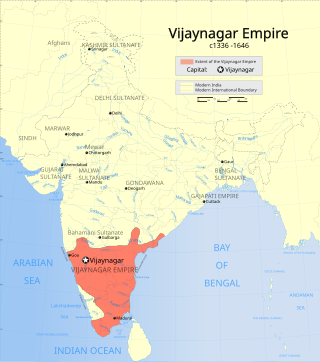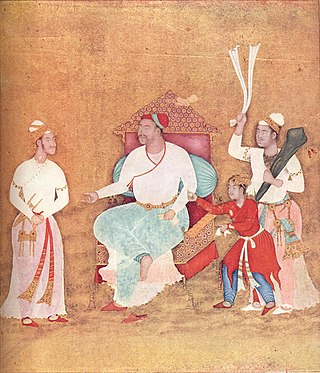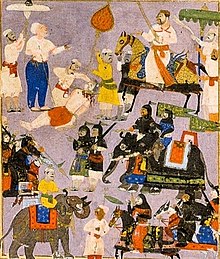
The Vijayanagara Empire was a medieval Hindu empire that ruled much of southern India. It was established in 1336 by the brothers Harihara I and Bukka Raya I of the Sangama dynasty, members of a pastoralist cowherd community that claimed Yadava lineage.
The Deccan sultanates were five late-medieval Indian kingdoms—on the Deccan Plateau between the Krishna River and the Vindhya Range—that were created from the disintegration of the Bahmani Sultanate and ruled by Muslim dynasties: namely Ahmadnagar, Berar, Bidar, Bijapur, and Golconda. The sultanates had become independent during the break-up of the Bahmani Sultanate. The five sultanates owed their existence to the declaration of independence of Ahmadnagar in 1490, followed by Bijapur and Berar in the same year. Golconda became independent in 1518, and Bidar in 1528.

Krishnadevaraya was an emperor of the Vijayanagara Empire reigning from 1509 to 1529. He was the third monarch of the Tuluva dynasty, and is considered to be one of the greatest rulers in Indian history. He ruled the largest empire in India after the fall of the Islamic Delhi Sultanate. Presiding over the empire at its zenith, he is regarded as an icon by many Indians. Krishnadevaraya earned the titles Andhra Bhoja, Karnatakaratna Simhasanadeeshwara, Yavana Rajya Pratistapanacharya, Kannada Rajya Rama Ramana, Gaubrahmana Pratipalaka and Mooru Rayara Ganda. He became the dominant ruler of the peninsula by defeating the sultans of Bijapur, Golconda, the Bahmani Sultanate and the Gajapatis of Odisha, and was one of the most powerful Hindu rulers in India.

Ibrahim Qutb Shah Wali, also known by his Telugu names Malki BhaRama and Ibharama Chakravarti, was the fourth monarch of the kingdom of Golconda in southern India. He was the first of the Qutb Shahi dynasty to use the title "Sultan". He ruled from 1550 to 1580. He lived for seven years in exile at the court of Vijayanagara as an honoured guest of Rama Raya. Ibrahim is known for patronizing Telugu extensively because he was moved by a genuine love for the language.

The Sultanate of Bijapur was an early modern kingdom in the western Deccan and South India, ruled by its reigning dynasty of the Adil Shahi or Adilshahi. Bijapur had been a taraf (province) of the Bahmani Sultanate prior to its independence and before its political decline in the last quarter of the 15th century and eventual break-up in 1518. It was a member of the Deccan Sultanates, the collective name of the five successor states of the Bahmani Sultanate. The Bijapur Sultanate was fully absorbed into the Mughal Empire on 12 September 1686, after its conquest by Mughal Emperor Aurangzeb.

The Battle of Talikota, also known as that of Rakkasagi–Tangadagi, was a watershed battle fought between the Vijayanagara Empire and an alliance of the Deccan sultanates. Despite the Vijayanagara army being larger, they were comprehensively defeated. The battle resulted in the defeat and death of Rama Raya, the de facto ruler of the Vijayanagara Empire, which led to the immediate collapse of the Vijayanagara polity and reconfigured South Indian and Deccan politics.
Pemmasani Nayaks were a ruling clan in the south Indian state of Andhra Pradesh. They came into prominence during Vijayanagara Empire. After the Battle of Talikota in 1565 AD, the collapse of Vijayanagara Empire led to the emergence of Pemmasani Nayakas in the Rayalaseema region. They belonged to the Kamma social group.
Tuluva Narasa Nayaka was an Indian general a Bunt chieftain and later an Imperial Regent who founded the Tuluva dynasty of the Vijayanagara Empire. He was the father of the Emperors Viranarasimha Raya, Krishnadevaraya and Achyuta Deva Raya.
The Aravidu Dynasty was the fourth and last Hindu dynasty of Vijayanagara Empire in South India. Its founder was Tirumala Deva Raya, whose brother Rama Raya had been the masterful regent of the last ruler of the previous dynasty. Rama Raya's death at the Battle of Talikota in 1565 led to the subsequent destruction of Vijayanagar by the combined forces of the Muslim states of the Deccan. The Aravidu family claimed to be Kshatriyas and were based in Andhra region. They claimed to belong to the Atreya gotra and traced their lineage to the Eastern Chalukya king Rajaraja Narendra.
Tirumala Deva Raya was the first crowned Emperor of Vijayanagara from the Aravidu Dynasty. He was the younger brother of Rama Raya and the husband of princess Vengalamba, making him the son-in-law of Emperor Krishna Deva Raya. Following the Battle of Talikota, he rescued the last Tuluva Emperor, Sadasiva Raya, and relocated the imperial capital to Penukonda. After Sadasiva's death in 1570 CE, he ascended as the Emperor of Vijayanagara. He was succeeded by his son, Sriranga I in 1572.
Sriranga Deva Raya was the second Emperor of Vijayanagara from the Aravidu Dynasty. He reigned from the fortress of Penukonda. Sriranga succeeded his father, Emperor Tirumala Deva Raya. After the fall of Vijayanagara to the Turko-Persian Sultanates of Deccan, he carried out the restoration of the empire from Penukonda. His reign was marred by repeated invasions and subsequent losses of territory to his Turko-Persian Muslim neighbours.

Venkatapati Raya was the third Emperor of Vijayanagara from the Aravidu Dynasty. He succeeded his older brother, the Emperor Sriranga Deva Raya as the ruler of Vijayanagara Empire with bases in Penukonda, Chandragiri and Vellore. His reign of nearly three decades saw a revival in the strength and prosperity of the empire. He successfully dealt with the Turko-Persian Deccan sultans of Bijapur and Golkonda, the internal disorders, promoting economic revival in the realm. He subdued the rebelling Nayakas of Tamil Nadu and parts of present-day Andhra Pradesh.

The Battle of Raichur was fought between the Vijayanagara Empire and the Sultanate of Bijapur in 1520 in the town of Raichur, India. It resulted in a decisive victory for Vijayanagara forces, and the Bijapur ruler was defeated and pushed across the river Krishna.
Events from the year 1565 in India.

The Sultanate of Ahmednagar or the Nizam Shahi Sultanate was a late medieval Indian Muslim kingdom located in the northwestern Deccan, between the sultanates of Gujarat and Bijapur, ruled by the Nizam Shahi or Bahri dynasty. It was established when Malik Ahmed, the Bahmani governor of Junnar after defeating the Bahmani army led by general Jahangir Khan on 28 May 1490 declared independence and established the Nizam Shahi dynasty of the Sultanate of Ahmednagar.

Hussain Nizam Shah I was the preeminent ruler of the Ahmadnagar Sultanate and the leading figure of the coalition of the Deccan Sultanates during the Battle of Talikota. Notably, Hussain Nizam Shah was responsible for taking prisoner and beheading Rama Raya of Vijayanagara after the Battle of Talikota.

The Deccanis or Deccani people are an Indo-Aryan ethno-religious community of Deccani-speaking Muslims who inhabit or are from the Deccan region of Western and Southern India. The community traces its origins to the shifting of the Delhi Sultanate's capital from Delhi to Daulatabad in 1327 during the reign of Muhammad bin Tughluq. Further ancestry can also be traced from immigrant Muslims referred to as Afaqis, also known as Pardesis who came from Central Asia, Iraq and Iran and had settled in the Deccan region during the Bahmani Sultanate (1347). The migration of Muslim Hindavi-speaking people to the Deccan and intermarriage with the local Hindus whom converted to Islam, led to the creation of a new community of Hindustani-speaking Muslims, known as the Deccani, who would come to play an important role in the politics of the Deccan. Their language, Deccani, emerged as a language of linguistic prestige and culture during the Bahmani Sultanate, further evolving in the Deccan Sultanates.
Darya Imad Shah was the third Sultan of Berar. He reigned between 1530 and 1561.

The Deccani–Vijayanagar wars were a series of wars between 1495 to 1678 that pitted the rival powers of the Deccan Sultanates against the Vijayanagar Empire. Over the course of approximately 120 years, these two entities engaged in a series of wars and skirmishes that were marked by significant displays of military strength and strategic maneuvering.

The Krishnadevaraya's Bahamani Expedition was a pivotal event in the history of the Bahmani dynasty and the Vijayanagara Empire. It marked a significant escalation in tensions between the two powers.











